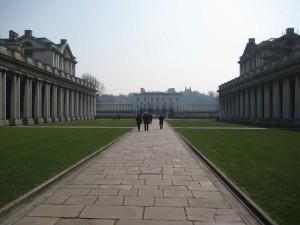TIME STANDS STILL

Turning away from the Thames, The Royal Observatory appears on the hilltop.
(P. Ferguson image, March 2011)
(Scene – March 2011 – Reviewing camera pictures as we stroll across the grounds towards the river Thames)
As we walk towards the Thames my mind turns to September 1940 and the start of the Blitz on London, England. Is that Edward R. Murrow I hear as I watch out over the landscape?
“This is London”…“The noise that you hear at the moment is the sound of the air raid siren”…“I am standing again tonight on a rooftop looking out over London”.
Time stands still, for however brief, as the images run through my mind, the Heinkel 111 bombers above the Isle of Dogs, the falling wall at 23 Queen Victoria Street captured by a City Police photographer on May 11, 1941 and many others.
At the water’s edge I look for St. Paul’s Cathedral which today is obscured through the haze, but it is there, another work of wonder by Christopher Wren. I wish we could see the dome from here, but still I recall the famous picture of this architectural jewel shrouded in the smoke and flames of December 29, 1940; and the Bomb Disposal team who on September 12, 1940 also saved the landmark from an unexploded bomb. I segue and think of Winston Churchill with his famed “Action this Day” memos eager to reward gallantry on the homefront of which two George Crosses were awarded for dismantling the bomb at St. Paul’s. It is also good to remind myself that the Blitz occurred across this land, in Scotland, Wales and Northern Ireland.
This in turn takes me to film, Danger UXB (1979) with Anthony Andrews, the story of a bomb disposal team working in the United Kingdom. Then to The Gathering Storm (2002) starring Albert Finney as Churchill, the man who led Britain during the Second World War, who participated in the charge at Omdurman with the 21st Lancers in 1898, and whose “character” portrait was famously captured in December 1941 by Yousuf Karsh in Ottawa, Canada.
(Scene – The couple turns away from the river moving towards The Old Brewery for a cup of tea)
With more pictures to review our eyes now gaze upon the many other fine buildings looking for details that may be interesting to capture. I look upwards to the Royal Observatory and smile as I recall my visit there a number of years ago, seeing the restored timepieces, and how these objects became the impetus for the four-part film series Longitude (2000) starring Jeremy Irons and Michael Gambon.
As we head towards the café in The Old Brewery I am eager to find a place to connect with my new pictures. How will I use them? A cup of tea will help…I wonder what time it is?
…to be continued

Comments